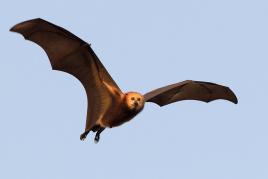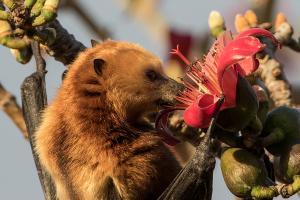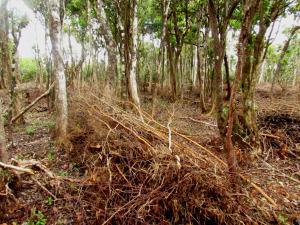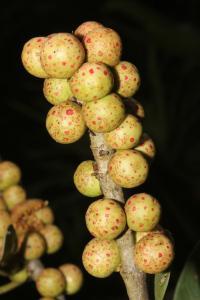 Here’s a depressing emergency post by Fabiola Monty.
Here’s a depressing emergency post by Fabiola Monty.
—
I started working on this article to discuss how useful science is being ignored in Mauritius.
The Mauritian government has decided to implement a fruit bat cull as an ‘urgent response’ to the claims of huge economic losses by fruit farmers, a decision not supported by scientific evidence. We have now received confirmation in Mauritius through a local press communiqué that on 7 November 2015, The Mauritian Ministry of Agro Industry and Food Security in collaboration with the local Police Department and Special Mobile Force will start the culling of 18,000 bats in their natural habitats “with a view to reducing the extent of damages caused to fruits by bats”.
Tackling human-wildlife conflicts can indeed be challenging, but can the culling of 18,000 endemic Mauritian flying fox (Pteropus niger) resolve ‘human-wildlife conflict’ in the land of the dodo? In the case of Mauritius, scientific evidence not only demonstrates that the situation has been exaggerated, but that there are alternatives to bat culling that have been completely brushed aside by policy makers.
 Are the Mauritius fruit bats agricultural pests?
Are the Mauritius fruit bats agricultural pests?
While fruit bats are being labelled as serious pests, scientific evidence shows instead that their impacts have been exaggerated. A recent (2014) study indicates that bats damage only 3-11% of fruit production, with birds also contributing to 1-8% of fruit loss. Rats are also probable contributors to fruit damage, but the extent remains unquantified. Interestingly, more fruits are lost (13-20%) because they are collected in time and are left to over-ripen.
While the results of the study were communicated to legislators a few months before they made the decision to cull, it is clear that these were ignored in favour of preconceived assumptions.
Are there too many fruit bats?
One of the arguments used to justify the bat cull in addition to the claim that they damage fruits is that the bat population has increased in the past few years. However the official estimate of 90,000 bats is contested by experts. As stated by the IUCN SSC Bat Specialist Group: “The claims that the Mauritius fruit bat population is increasing exponentially and now numbers over 90,000 individuals are unlikely. The disturbance-based counting method used for estimations is not considered best practice for survey and monitoring of colonial Pteropus species as it results in double-counting and inflated estimates.”
Expected benefits from the bat cull
The cull is being put forward as an action that will be beneficial for all Mauritians. It is expected that it will not only address the huge economic losses incurred by fruit farmers, but that it will also ensure the availability of seasonal fruits for the Mauritian population. But if the bats are contributing to only 3-11% of fruit loss, how is the cull going to achieve its expected goals? What about the uncollected over-ripe fruits? What about the damage caused by other species? As explained in the video below, the decision to cull the Mauritius fruit bat is not going to address the losses claimed by the fruit farmers:
https://www.youtube.com/watch?v=ryoRgDg4JKo
 What about no-regret long-term solutions?
What about no-regret long-term solutions?
While there are several mechanisms leading to fruit loss, the contribution by bats still need to be quantified. Some of the proposed alternatives such as the effective installation and use of tree netting are important immediate solutions, but these also need to be cost-effective.
Investing in the restoration of the native forests and the planting of appropriate native trees to increase food sources for the bats represent ‘no regrets’ long-term solutions that need to be recognised and implemented.
While Mauritian native forests are severely degraded by invasive plants, the native trees are able to recover, to increase in fitness and produce more fruits soon after invasive plants are removed (Monty et al. 2013). Such holistic conservation approaches are being implemented at small scales (covering only 1% of native forests). It is more than urgent that forest restoration is considerably expanded on the island, particularly when low-cost strategies for invasive plant control have been developed that cut the original cost per hectare by almost 8 times.
 Furthermore, there are specific trees that can be planted at a large scale to provide alternative food sources to fruit bats instead of commercial crops. The ideal candidate trees are native figs, particularly Ficus reflex and Ficus rubra. These are native species, they grow quickly, they produce many fruits throughout the year that can be eaten by fruit bats, and they are adaptable to different habitats.
Furthermore, there are specific trees that can be planted at a large scale to provide alternative food sources to fruit bats instead of commercial crops. The ideal candidate trees are native figs, particularly Ficus reflex and Ficus rubra. These are native species, they grow quickly, they produce many fruits throughout the year that can be eaten by fruit bats, and they are adaptable to different habitats.
When the decision on bat culling was shared with members of the Mauritian Parliament on 6 October 2015, The Minister of Agro-Industry and Food Security, Mahen Seeruttun, stated the following:
“…. Moreover, our native forests which are primary roosting and feeding sites for bats are being increased and appropriate fruit trees such as jack fruit, mangoes and guavas are being planted to provide food for bats”.
This line of thinking goes against any logic concerning conservation in Mauritius: we need to get rid of invasive introduced plants and not plant more of them, and surely not in native forests. Jack fruit, mangoes and guavas are introduced plants, with the highly invasive strawberry guava being one of the greatest threats to native biodiversity.
Why has Mauritius, my own country, once a model of conservation success to the world, fallen so low as to decide to kill 18,000 threatened bats based on the advice of ‘pseudo-ecologists’? The island is lucky to have science on its side, providing opportunities for effective decision-making, Yet they have opted instead to do a dangerous, pointless and stupid cull!
Scientific sources:
Raider C. & Florens, FBV. 2006. Current decline of the ‘Dodo tree’: a case of broken down interactions with extinct species or the result of new interactions with alien invaders? In: Emerging Threats to Tropical Forests. Laurance, W.F. and Peres, C.A.(Eds.), pp.199-214. University of Chicago Press, Chicago
Baider, C & Florens, FV. 2011. Control of invasive alien weeds averts imminent plant extinction. Biological Invasions 13:2641-2646
Florens, FBV & Baider, C. 2013. Ecological restoration in a developing island nation: how useful is the science? Restoration Ecology 21: 1-5
Florens, FBV. 2013. Conservation in Mauritius and Rodrigues: challenges and achievements from two ecologically devastated oceanic islands. Conservation Biology: Voices from the Tropics, Chapter 6. John Wiley & Sons, Ltd, Eds: PH Raven, NS Sodhi, L Gibson, pp. 40-50. doi:10.1002/9781118679838.ch6
Monty, MLF, Florens, FBV, Baider, C. 2013. Invasive alien plants elicit reduced production of flowers and fruits in various native forest species on the tropical island of Mauritius (Mascarenes, Indian Ocean). Tropical Conservation Science 6: 35-49.
Oleksy, R. 2015. The Impact of the Mauritius Fruit Bat (Pteropus niger) on Commercial Fruit Farms and Possible Mitigation Measures. Final Report.

